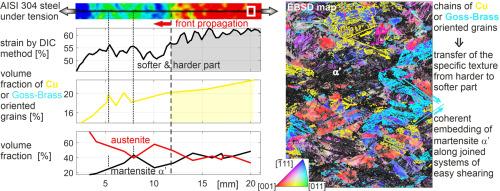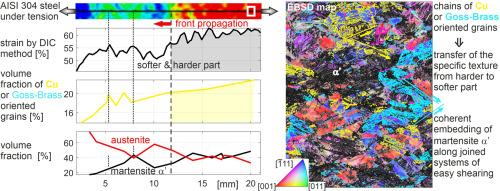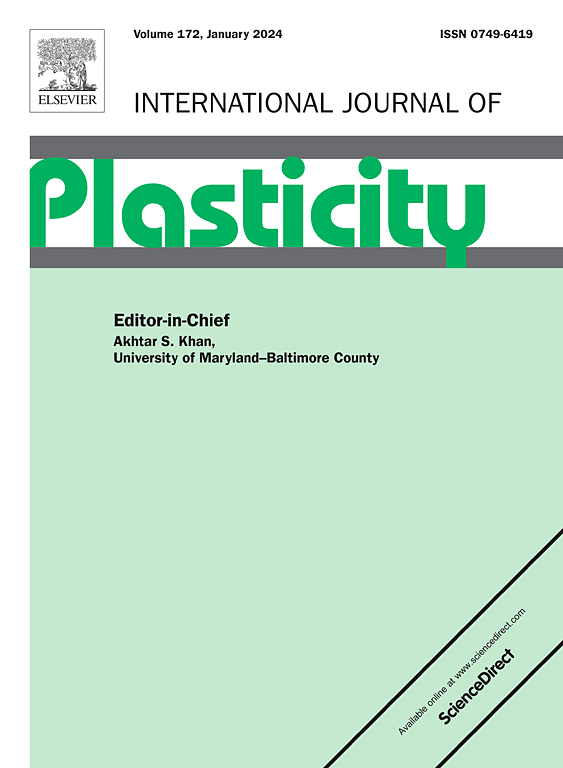Plastic flow instability in austenitic stainless steels at room temperature: Macroscopic tests and microstructural analysis
IF 9.4
1区 材料科学
Q1 ENGINEERING, MECHANICAL
引用次数: 0
Abstract
AISI 304 steel experiences plastic flow instability during tension at room temperature if appropriate conditions are applied: a low strain rate and a sufficiently long gauge section of the sample. Then, propagation of the strain-localised band is activated. The electron backscattered diffraction (EBSD) research revealed that the reason is not only the difference in the content of the secondary phase – martensite α’ across the front face, but also the change in the volume fraction of austenite grains with Copper (Cu) and Goss-Brass (GB) orientation. Consequently, there is a division between two areas of high and limited deformation capacity. The tendency to maintain the continuity of deformation fields induces a massive rotation of austenite grains to Cu and GB orientations, which then undergo shearing and phase transformation. As a result, momentary strain accumulation leaves behind a stiffer zone. It is shown that the trapping of austenite grains prone to large deformations, inside the matrix with Cu and GB orientations, makes the formation of a plastic strain front possible. These features improve the ductility and strength of the 304 steel over 316L and 316LN at room temperature. The in-situ EBSD tension studies for the considered grades reveal three developing textures, with their comparison showing a gradual decrease in the preferences of the Cu and GB components. Thus, the appearing bands of the accumulated strains in 316L are limited by the Cu and GB areas, while such blockages do not occur in 316LN. The presented strengthening mechanism is confirmed by the digital image correlation (DIC) measurements. The root-mean-square (RMS) function of strains along the tensile direction, characterising the linear surroundings of the considered point, is introduced as a tool for linking the micro and macro scales. The experimental results provide a basis for explaining discontinuous front propagation at a temperature near 0 K.


奥氏体不锈钢在室温下的塑性流动不稳定性:宏观测试和微观结构分析
在室温条件下,AISI 304 钢在拉伸过程中会出现塑性流动不稳定性,如果采用适当的条件:低应变率和足够长的试样截面。然后,应变定位带的传播被激活。电子反向散射衍射 (EBSD) 研究表明,原因不仅在于整个正面的次生相--马氏体 α' 的含量不同,还在于铜 (Cu) 和戈斯-布拉斯 (GB) 取向奥氏体晶粒体积分数的变化。因此,变形能力分为高变形能力和有限变形能力两个区域。保持变形场连续性的趋势导致奥氏体晶粒向 Cu 和 GB 方向发生大量旋转,然后发生剪切和相变。因此,瞬时应变积累会留下一个较硬的区域。研究表明,在具有 Cu 和 GB 取向的基体内部,容易发生大变形的奥氏体晶粒的捕获使塑性应变前沿的形成成为可能。与 316L 和 316LN 相比,这些特点提高了 304 钢在室温下的延展性和强度。对所考虑的钢种进行的原位 EBSD 拉伸研究揭示了三种发展中的纹理,其比较显示出铜和 GB 成分的偏好逐渐降低。因此,在 316L 中出现的累积应变带受到了铜和 GB 区域的限制,而在 316LN 中则没有出现这种阻塞。数字图像相关(DIC)测量结果证实了上述强化机制。拉伸方向应变的均方根(RMS)函数描述了所考虑点的线性周围环境,被引入作为连接微观和宏观尺度的工具。实验结果为解释温度接近 0 K 时的不连续前沿传播提供了依据。
本文章由计算机程序翻译,如有差异,请以英文原文为准。
求助全文
约1分钟内获得全文
求助全文
来源期刊

International Journal of Plasticity
工程技术-材料科学:综合
CiteScore
15.30
自引率
26.50%
发文量
256
审稿时长
46 days
期刊介绍:
International Journal of Plasticity aims to present original research encompassing all facets of plastic deformation, damage, and fracture behavior in both isotropic and anisotropic solids. This includes exploring the thermodynamics of plasticity and fracture, continuum theory, and macroscopic as well as microscopic phenomena.
Topics of interest span the plastic behavior of single crystals and polycrystalline metals, ceramics, rocks, soils, composites, nanocrystalline and microelectronics materials, shape memory alloys, ferroelectric ceramics, thin films, and polymers. Additionally, the journal covers plasticity aspects of failure and fracture mechanics. Contributions involving significant experimental, numerical, or theoretical advancements that enhance the understanding of the plastic behavior of solids are particularly valued. Papers addressing the modeling of finite nonlinear elastic deformation, bearing similarities to the modeling of plastic deformation, are also welcomed.
 求助内容:
求助内容: 应助结果提醒方式:
应助结果提醒方式:


